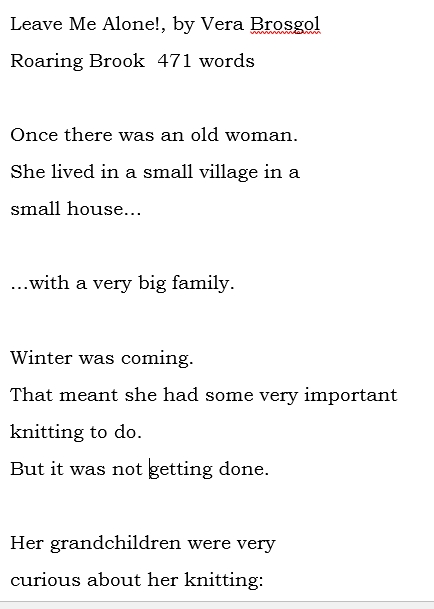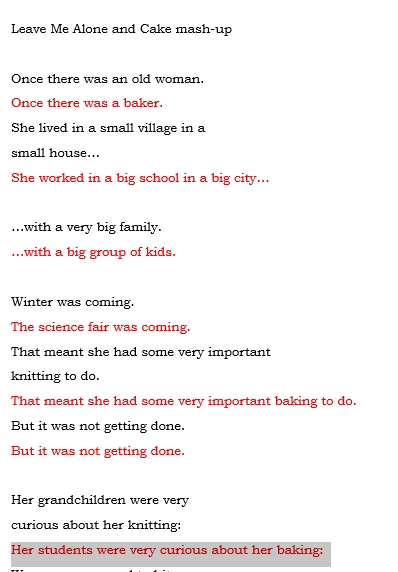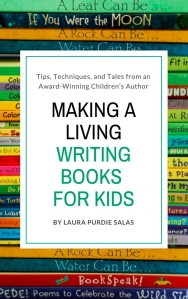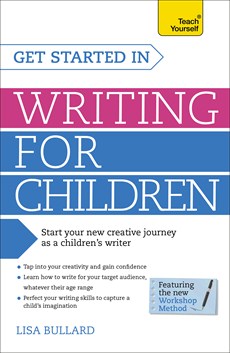All of my trade published picture books are either nonfiction, poetry, or a mash-up of the two. I want to write fiction picture books, too, but I struggle with plot/structure. Over the past year or so, I’ve analyzed many fiction picture books and typed out a bunch of my favorites, too, hoping to absorb their secrets to success. I was trying to use them as mentor texts by osmosis, I guess. (“Mentor text” is a term from the education world for a text that you use as an example for some element of writing that you ask your students to study and then incorporate. If you go to my website at http://www.laurasalas.com and type in “mentor text” in the search box, you’ll find some other things I’ve said about using mentor texts in writing.) But osmosis just wasn’t working.
Recently, I tried something new. I literally used a picture book I loved as a template. I took a picture book that had a structure I loved–one that felt so neat and tidy and perfect I wished I had written it. I typed out the entire text. I entered it into my Picture Book Plot Analysis spread sheet, where I note things like Main Character’s Traits, Story Problem, MC Action #1, #2, etc.
Hmm…this is hard to explain. I’m going to show you with a different book! Let’s pretend the book I chose for a mentor text was Vera Brosgol’s Leave Me Alone! (another picture book that I love the structure of). I took the typed out text:
I thought about the basic problem. A character is trying to do something lovely and necessary for a group of people, but those very people are making it impossible for her to do that thing.
I looked through my looonnnnnng list of picture book ideas for an idea that could fit with the structure of the much loved mentor text. I found a character that I thought would be a good fit for this, even though the story problem would need to shift.
I spent some time that night hashing out what actions the main character would take that could sort of mirror the actions of the main character in my mentor text.
The next morning, I opened the document, renamed it, and started writing my own lines right in between the original lines. I tried to stick as close to that original structure and pacing as possible. Here’s an example of what it might have looked like:
As the story went along, it drifted a little further afield of the original mentor text because…well, because it was a different story. But I was careful to keep the pacing the same, with my character taking action and running into obstacles in the exact same spots as in the mentor text. And in consequent drafts, the voice, and phrasing changed a lot. Because I am a different writer than the author of the mentor text. The manuscript I sent off to a few publishers would not be immediately recognizable as being modeled after the mentor text. But it was. And I think it worked! My critique group gave it a big thumbs up, and after some more polishing, I sent it out to a few editors to see what would happen.
What’s also fun is that even while just making up this short example for this post, ideas started pouring into my head. Because of course the kids who are interested in the Science Fair and the cake would have all sorts of funny questions about the chemistry of baking, and maybe they’d want to do experiments and…well, you get the idea. So it’s not only a draft generator, it’s also an idea generator in some ways.
I plan to do this with several more stories. I’m hoping that this more active form of patterning my story after a story I love will help me finally improve my plotting/structuring skills. I just thought I’d share it here in case it’s something you might like to try. In fact, wouldn’t it be a blast to choose a picture book and have a bunch of people all creating their own manuscripts patterned after it, just as a craft exercise? Hmmm….






I find this very helpful and timely. I read a book recently and I immediately thought, this is what I’m trying to accomplish with my MS. The subjects are very different, but the pacing and structure felt right. I typed it out so I could study it further. I haven’t really accomplished much more than that but I will give your suggestion a try. Thank you!
Thanks, Michelle! Would love to hear if it is useful–good luck!
I want to try it. This post is SO nourishing. Appreciations for YOU, Laura!
Thank you, Jan! Honestly, it’s pretty fun:>)
Perfect timing for me to read this! I just typed out a PB story that I love just to see what it would look like on the page, and a story idea came to mind that I think will fit this structure and pacing. I’m still in the idea stage, but reading your post makes me think I’m on the right track. Thanks, Laura!
Awesome, Linda! Go for it! It might be magic. If nothing else, it will be a useful writing exercise. :>)
Reblogged this on Terry Pierce and commented:
Laura Purdie Salas gives an excellent demonstration on how to use a “mentor text” on her blog. Enjoy!
What a helpful post. I now understand mentor texts and I understand how I can use them. I can hardly wait until I get to my writing time this week. Thanks for being so generous with your ideas.
Fantastic, Susan! I’m so glad you found this useful. Happy writing!